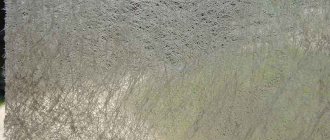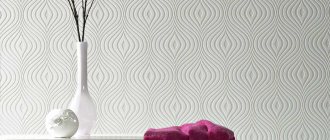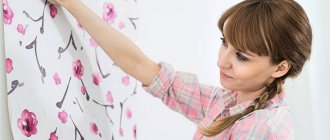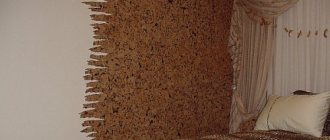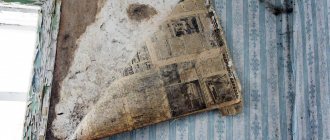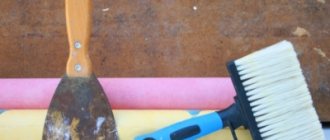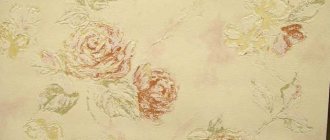If we are not talking about a new building, when carrying out repair work you have to decide what to do with the old covering on the walls. Ideally, it should be removed, but this is a labor-intensive process that lengthens the repair time. If paint has been applied to the walls, there is a desire to leave it. Let's find out in what cases it is possible to glue wallpaper on water-based paint and how to do it in order to achieve a high-quality and durable coating?
Will the wallpaper stick to the “water emulsion”?
It is permissible to glue new finishing material directly onto old paint, but only under certain conditions, the main one of which is the strength of the paint coating.
Let's consider cases when it is necessary to remove paint from walls:
- If it does not adhere well to the surface, it peels off in large fragments.
Sometimes it is difficult to visually determine how firmly the painted layer adheres. You can check it with tape: a piece of it is glued to the wall and then torn off. The absence of paint particles on the tape is an indicator of the strength of the coating.
- The surface of the paint was covered with a network of small cracks and chips.
- There are pockets of mold or mildew on the wall.
In all other cases, applying wallpaper to water-based or oil-based paint is possible with appropriate preliminary preparation.
How to properly prepare the surface for pasting
Without boring our reader too much, we’ll say right away that this approach is allowed, but only if a number of requirements are met, otherwise you can’t expect a long service life of the wallpaper. In this part of the article, we will analyze all the nuances concerning the foundation and look at all the technological stages that we need to go through.
Types of wallpaper
When you come to a hardware store, you will see that there are a large number of varieties of wallpaper presented on the shelves. They can have a different base, differ in thickness, color, and pattern. All this determines not only the appearance, but also the performance, including the ease of gluing. For this reason, it is necessary to correlate these parameters with the characteristics of the base on which they will be glued.
Exposed cement plaster is not suitable for wallpaper
Option #1. Thin wallpaper
Thin wallpapers, which include budget paper, vinyl, expensive silk-screen printing and fabric materials, usually have no more than two layers. Therefore, when gluing, they repeat the surface of the base, and even small irregularities appear through them, which is especially true for smooth models. Preparing the surface for them can take a lot of time, especially when it comes to expensive materials. Such walls and ceilings are puttied at least 4-5 times, achieving perfect smoothness.
If the texture of such wallpaper is embossed, then it may well hide small irregularities, but still you shouldn’t tempt fate, since what is invisible during the work process will definitely catch your eye when redoing something will be problematic. Therefore, we always keep this information in our heads.
Paper wallpaper consists of two layers
Thin wallpaper is much easier to glue, since it is more elastic and does not have much mass. When glued to water-based paint, they will not tighten it too much, that is, damage to its integrity is less likely. The exception is vinyl - this material is poorly saturated, it is inelastic and can tear off pieces of paint when the glue dries.
Option #2. Thick wallpaper
Thick three-layer wallpaper on a non-woven basis can make most minor surface imperfections invisible, so the requirements for the surface on which they are glued are less stringent. By themselves, they are quite heavy, but when gluing they are not impregnated, but only smeared on the wall, so the material does not stretch much, and therefore does not shrink back - the solution is quite suitable for walls painted with water-based emulsion.
Thick non-woven wallpaper
Option #3. Liquid wallpaper
Another type of wallpaper is liquid. This material is a paper paste tinted and diluted in water, which is applied to surfaces in the manner of conventional putty. This wallpaper is the most undemanding to the base, as it fills all the unevenness. Moreover, the more flaws there are on the surface, the better they will hold up, but only within reason. What this means is that material from very deep potholes can crumble over time. However, the evenness of the surface is guaranteed in any case.
Color palette of liquid wallpaper
They can also be glued to water-based emulsion, like other options, but only if certain conditions are met, which we will talk about later.
Application of liquid wallpaper
Prices for different types of wallpaper
Wallpaper
Types of water-based paint
There are several varieties of water-based paints. They have one thing in common - water is used as a solvent, but the base is different, which affects the performance properties.
Option No. 1 Polyvinyacetate based paint
The most inexpensive and low-quality version of water-based paint is made based on polyvinyl acetate (PVA) dispersion. Such a base will have less strength compared to its competitors. Its surface is porous and may peel off in places if applied incorrectly. This paint is applied in two thin layers. It is easily washed off with warm water.
It is better not to glue wallpaper onto a base coated with such paint, although if you are sure that the material will not peel off, you can try. In places where the paint is peeling off, it must be wetted with warm water and cleaned, getting to the strong places.
Polyvinyacetate based paint
Advice! With this approach, you leave different types of bases on the surface. On exposed plaster, the wallpaper may not stick properly and may come off over time. Therefore, it is recommended to first putty the cleaned areas and sand them after drying.
The quality of polyvinia acetate emulsion varies. Good compositions allow wallpapering without the risk of further peeling, while cheap options, naturally, cannot provide such a guarantee. Therefore, our advice is, if you do not know what exactly the walls were painted with, clean off such coating completely. This is not difficult to do, but be prepared for a lot of dirt, so first cover the floors in the room with plastic film.
Option #2. Polymer based paint
If your walls are painted with polymer water-based paint, then you can hang wallpaper on them with more confidence. These compositions include latex, silicone and acrylic paints. All of the options listed are washable, so they do not simply dissolve in water. If you try to scrape them off the surface with a spatula, they will come off in pieces, whereas the PVA-based option will crumble into powder.
A distinctive feature of polymer compositions is their durable surface, which is not afraid of damage and moisture. It is preferable to glue wallpaper onto such surfaces, but only if there are no peelings on it, which can also appear due to improper painting work.
Silicone paint cannot be washed off with water.
Elimination of flaws is carried out in almost the same way - we clean out poorly adhering places with a spatula, level out differences using putty, sand it and you can get to work.
Advice! If you are not sure of the reliability of the polymer water-based emulsion, then to remove it you will need to buy a special remover, after processing which the paint peels off very easily.
Prices for water-based paints
Water-based paint
Surface preparation
Now let's discuss in more detail the process of preparing walls for wallpapering.
We start by inspecting them for cracks, peeling, pockets of mold, and damp spots. All of these points, one way or another, will affect the quality of adhesion to the wallpaper and the strength of the paint itself.
Preparing the walls
If there is mechanical damage, we take a hard spatula and begin to strip the paint to those places where it seems to us that it is already holding firmly. If the paint comes off very easily and in whole layers, as shown in the photo below, then it is best to clean it all off from the base, otherwise you risk ruining the new repair. If this effect is not observed, but doubts still haunt you, then take ordinary tape, stick it to the wall along the cleaned edge and pull sharply. If pieces of paint come off, then cleaning must be continued; if everything is in order, then you don’t have to worry about the fate of the wallpaper.
This is how water-based paint comes off the walls
If you have traces of mold on the paint, this may indicate that your walls are freezing in this area or that moisture is constantly getting on them from somewhere. Perhaps communications are leaking. In any case, the cause will need to be eliminated, otherwise your new wallpaper will soon look no better than the old whitewash.
If mold is found in the corner of the room, then there is a 90% chance that it is freezing. In this case, you should take care of insulation, and it is better to do it outside the room, on the street side. If this is not possible, then you can install a heat insulator from the inside, but usually this will require additional plasterboard covering of the walls... In general, the problem is quite serious, and its solution requires appropriate measures.
The same goes for dampness. It is necessary to find its source and eliminate it. It happens that mold appears on the walls due to poor ventilation of the room. This is the simplest case - here we will check the ventilation, adjust its operation and simply eliminate the fungus. The easiest way to kill mold is with “Whiteness” or any other chlorine-containing composition. The walls are carefully processed, after which the mold disappears literally before our eyes.
Black mold will ruin both your wallpaper and your health.
Prices for deep penetration primer
Deep penetration primer
Before starting any dirty work, you need to vacate the room and lay the floor. If this is not possible, then we move everything to the center of the room and cover it with the same polyethylene or thick fabric.
Furniture is worth protecting
After cleaning, we inspect the walls for unevenness - it is quite possible that crooked walls were painted. If there are such in small quantities, they should be quickly removed with putty - it can only be applied to a strong base, so these places will also have to be cleaned. If there are serious differences in plane, then it may be worth making a decision about plastering the walls, but if the evenness of the finish is not important to you, you can skip this stage.
Correction of irregularities
Next, all cleaned areas must be treated with a primer. Deep penetration acrylic primer is perfect for these purposes. Apply it with a brush and let it dry according to the instructions for use.
Primer of walls
Then we begin to apply putty. Please note that if your walls are painted with polymer vapor-proof paint, for example, latex, then you should choose a putty with similar properties. You can buy it ready-made, in small buckets. The putty is applied in such a layer that it reaches the same level as the paint. Then it is left to dry for 5-6 hours.
After the putty has dried, it must be cleaned until smooth. Use fine abrasive 200-240 for this. Use circular motions to ensure the material is scraped off evenly.
Sanding putty
Having received the repaired surface, you can begin gluing wallpaper. We will describe this process in detail in the next chapter.
Let's give one more piece of advice on how to check the reliability of a base painted with water-based paint. Take a regular newspaper and glue it to the wall with wallpaper glue. After a day, try to remove it. If it comes off without paint and with difficulty, then everything is in order, but if it comes off, leaving behind bald spots, then it is better to clean everything down to the putty.
Video - How to remove paint from walls
Checking old coating
What can happen if you paste wallpaper directly onto a layer of paint? A happy outcome in this case is almost guaranteed to be excluded. The canvases may simply fall off due to low adhesion to the wall, peel off along with the paint, or become cracked. Therefore, checking and preparing the walls is mandatory.
First of all, the type of paint is determined. Not only the properties of the coating depend on it, but also the technology for its preparation before gluing the wallpaper to painted walls.
- Oil paint has a specific smell, forms a thicker layer and is much easier to peel off from the wall in separate fragments.
- The properties of enamel are similar to oil enamel, but it usually lasts much better.
- The layer of water-based emulsion, acrylic or latex, is thinner. Its adhesion strength to the wall is much higher.
USEFUL INFORMATION: Where is the right place to start gluing wallpaper: from the window or from the door?
Once you are sure that the old paint is indeed water-based, you should carefully examine its surface. At this stage, they look to see if there are any signs described above, and also check the strength of adhesion to the base of the wall using tape.
Checking the paint coating for durability
Advice from experts on working with an old layer of water-based emulsion:
- Cheap, easy-to-remove water-based coatings are recommended to be washed off completely. It can be removed with water as much as possible. This layer is not strengthened by the adhesive composition.
- If the quality of the paint is high, then it is better to create a solid base and stick wallpaper on it. Another small test is being carried out on the tensile strength of the CM coating. Newspaper is glued to the water-based paint; after it dries, you need to try to remove it. Where this is difficult to do, you can glue wallpaper without fear. If there are many problem areas, then the old finishing layer of paint is removed with hot water.
- As a rule, it is not the strength of the paint itself that is checked, but the layer of plaster and finishing putty underneath it. It is not difficult to wash off the paint. The reliability of the plaster and putty layer is important. Preparatory work will be added if, when removing the CM with water, the putty begins to peel off. A simultaneous check of the old layer of water-based emulsion and the plaster underneath is underway.
Technology for gluing wallpaper onto water-based paint
Before wallpapering, you don’t have to remove the paint layer if 2 conditions are met:
- with firm confidence in its strength and quality;
- with strict adherence to technology during preparatory work.
Disadvantages of walls painted with dispersion dyes may become apparent during the preparation process. Thus, when applying a primer, which is a mandatory step, peeling of the surface or the appearance of blisters may occur. In this case, removal of the old finish is necessary.
Choosing the right wallpaper
You can choose almost any new canvas; the main selection criterion is the weight of one sheet. Wallpaper that is too heavy will not adhere to the painted surface, no matter how thoroughly everything was prepared or what the best glue was used.
Among the variety of patterns, one should avoid patterns created using spraying, as such a technique adds weight to the products.
It is better to choose a non-woven type of canvas, but one with a paper base: the paint does not absorb moisture from the air, so the entire load will fall on the top layer of finishing. The bottom layer of paper ensures less weight of the canvas and allows air to circulate well. This means that the wallpaper will dry well, and it is also an excellent choice for rooms with high humidity, such as the kitchen.
Wallpaper type
Washable materials are great for areas where contamination is likely to occur. But this parameter should not be confused with water resistance: the latter implies the ability of the wallpaper to maintain the integrity of the coating, regardless of the degree of humidity inside the room.
Liquid wallpaper adheres perfectly to the existing layer of paint, simultaneously filling small cracks and minor irregularities.
In any case, before you start gluing wallpaper with acrylic paint, you must carefully prepare consumables, tools, and treat the work surface.
Materials and tools
Materials you may need:
- Putty for eliminating minor defects on walls.
- Primer. Its use is mandatory. It is better to give preference to deep penetration compositions based on acrylic. If the colored wall has a dark shade, then using a pigmented white primer it can be “painted” so that the old coating does not show through under the light-colored canvases.
- Non-woven wallpaper. They are preferable for use in this case: they are lighter than vinyl and stronger than paper.
- Adhesive composition. Better from a well-known manufacturer. This is the case when a low price most likely indicates low quality. There is no need to skimp on wallpaper glue.
Even a novice master will have tools for the job:
- Brush or vacuum cleaner.
- Spatula and grater. Will be required if you have to eliminate minor wall defects.
- Roller and brush. Needed when priming, as well as in the process of attaching wallpaper.
- Level, sharp scissors, painting knife, pencil.
- Rubber roller. It is convenient for them to smooth out the panels, preventing the formation of bubbles.
What wallpaper is suitable for pasting
It is better to choose non-woven wallpaper for gluing on similar walls. There are several positive points why it is worth gluing them:
- They are lighter and more pliable for application to surfaces that have an error;
- Dries quickly and stretches well.
It is better to choose non-woven wallpaper for gluing on similar walls.
An alternative can be liquid wallpaper. Even a beginner can easily handle them. Their main advantage is the ability to level the surface. It is applied with a spatula, the technique resembles working with solutions. It looks stylish and has a wide range of textures to choose from.
Their main advantage is the ability to level the surface.
A less successful option would be to use paper wallpaper. They are quite heavy and difficult to glue. After drying, if the walls have bumps or other defects, this will be very noticeable.
They are quite heavy and difficult to glue.
Preparing the walls
Stages of work:
- If necessary, uneven areas and cracks are cleaned and smoothed with putty.
- The entire surface is rubbed using fine sandpaper or an abrasive mesh. This will increase the adhesion of the smooth coating.
- The walls are freed from dust. You can use a brush, but a vacuum cleaner is better.
- A deep penetration primer is applied. This operation must be repeated at least twice, and in perpendicular directions. The second time is primed only after the first layer has completely dried.
USEFUL INFORMATION: Leveling bathroom walls with plaster: step-by-step instructions
After such processing, pasting is carried out in a standard way, guided by the rules for the selected type of wallpaper.
Proper installation of new wallpaper
Before starting wallpaper work, it is necessary to eliminate the possibility of drafts and also turn off the air conditioner. This is necessary for proper drying of the wallpaper. Opening windows and creating air movements is allowed only after the new wallpaper has completely dried.
Sequence of work:
- The section of the wall from ceiling to floor is slightly moistened with water. In this case, sections of old wallpaper that are weakly held on the walls are separated.
- The wall is coated with wallpaper glue.
- The same glue is applied to the canvas cut to the required size.
- The first canvas is being applied.
- Allow some time to assess the quality of the gluing. If after 10-20 minutes no bubbles or stains appear on the new canvas, and the pattern of the old wallpaper is not visible, then you can glue the wallpaper.
- If small bubbles appear, this is considered acceptable. After some time they should disappear.
- The wallpaper is left to dry.
We can conclude that it is advisable to hang wallpaper without removing the old coating. You can glue wallpaper over old strips if you comply with the listed conditions. However, in order to avoid unforeseen accidents, it is advisable to remove old wallpaper. To do this, they need to be moistened with water from a spray bottle, then left for several minutes, and then separated from the wall with a spatula.
Gluing process
Instructions for gluing wallpaper:
- Using a measuring tool, lines are laid on the wall that will help to correctly place individual fragments. This is much more reliable than gluing by eye.
- Pieces of wallpaper are cut to the required size. For insurance, it is better to leave a small margin of 2–3 cm.
If there is a pattern, careful cutting of the roll is required. It is often more profitable to cut off the necessary fragment from a new tube than to cut out and throw away significant pieces from the old one.
- Wallpaper glue is prepared according to the seller's recommendations indicated on the package.
- The glue is evenly applied to the fragment using a roller or brush. When gluing non-woven wallpaper, which is most preferable for this case, the wall is also covered with the adhesive, avoiding drops or smudges. The process of gluing vinyl on paper is described here.
- The piece is carefully applied to the marks on the base and smoothed with a rubber roller, a special spatula or a cloth in the direction from the center to the edges. This removes folds and expels air from under the surface of the wallpaper.
When creating a coating that has a general pattern and consists of individual stripes, an important point is the high-quality installation of the first fragment. Its oblique location will entail distortion of the rest, which is difficult or almost impossible to correct.
- Similarly, adjusting the pattern, the following strips are glued. To make the joints stand out less, it is better to start the process from the window.
- After the wallpaper has dried, remove excess with a painting knife. It will be easier to do this on a plinth or baguette.
A high-quality result is impossible without creating an appropriate microclimate in the room: drafts are eliminated for the entire duration of the process and the temperature is ensured around +18 °C. At higher temperatures, the wallpaper may sag; at lower temperatures, it will not dry well.
It will be easier to identify surface flaws during the pasting process if you provide lighting in the room from several sources so that the rays fall on the wall at an acute angle.
Conditions for choosing wallpaper for walls with water-based emulsion
Craftsmen do not recommend gluing heavy wallpaper - vinyl panels. They are thick and even special glue will not be able to hold them on a wall previously painted with water-based paint. Non-woven, liquid wallpaper is recommended. The price of paper for a 10 m roll with a width of 0.53 m starts from 345.00 rubles and reaches 1000.00 rubles. The base under them is leveled, stains and uneven coloring are removed. It is better not to purchase wallpaper of different thicknesses. The glue underneath dries at different times, which negatively affects the water-based coating. It is recommended to prepare special bases for this type of panel. They come in two types in rolls: paper base and non-woven material made from modified cellulose. The second type of base is more durable. Under paper and non-woven wallpaper, the adhesive base dries quickly. A non-woven roll of 10 m with a width of 0.53 m costs an average of 1300-1600 rubles.
Liquid wallpaper holds on more tightly than others. The average price per package is from 300 to 1000 rubles, depending on the brand. Packaging consumption per 1 m2 is an average of 3.5-5 m2. In addition, they apply easily to paint and hide surface defects.
But the best option remains non-woven panels for covering walls painted with water-based paint. This is a high quality finishing material, light in weight, with high performance qualities.
When the canvas is already glued, it is not recommended to press it to remove bubbles. They are driven out with a thick roller or a plastic spatula with a rubber tip. If the strip is often torn off, the grip is reduced.
Priming the water-based layer
A water-based emulsion with weak water-repellent properties will peel off if it is over-wetted with glue. The dye will get wet and, along with the new finish, will slide off the wall.
The base is strengthened with a primer. In addition, the adhesion of paintwork materials and the adhesive mixture improves. Fine quartz is introduced into the primer. The astringent components of the primer composition secure it to the base painted with emulsion. The glue clings to the grainy primer surface. In the primer, adhesive elements glue microcracks on the treated wall, thereby strengthening weak areas of the surface. Only after such treatment will it withstand the weight of the glued canvases.
The surface is cleaned of dust and dirt before applying a strengthening primer. The coating is carried out in 2 layers. Each subsequent one is applied to the dried previous one. Manufacturers indicate on the container the time for the coating layer to completely dry. The duration is also affected by air temperature and humidity. A primer composition is selected that interacts with the concrete base. It is recommended to use a white primer, then it will not bleed through the glued panels.
If the paint turns out to be oil-based
A low-quality, poorly adhering layer of such coating is removed in the most appropriate way. Oil-based paint is more difficult to remove from a wall than water-based paint. Methods for removing different types of old paint are described in detail here.
A durable old oil-based coating is covered with wallpaper after preparation: to increase adhesion, the wall is rubbed with coarse sandpaper and then covered with a layer of primer. On such a surface the wallpaper will stick firmly and for a long time.
Necessary equipment
This type of repair implies the presence of:
- brushes;
- roller (for applying glue, removing bubbles);
- stationery knife;
- scissors;
- pencil.
Some types of wallpaper must be cut with an allowance for alignment. If the drawing needs to be adjusted, then the necessary pieces must be cut off as work progresses. It should be trimmed along the bottom; it is better to remove excess with a stationery knife. The glue can be applied with a roller or brush.
How to remove water-based paint from walls?
If the paint on the walls does not adhere well or you decide not to risk the quality of the repair, but to remove it completely, then this can be done using the following methods:
- Wash off the paint with warm water. To do this, use a rough washcloth or mitten. Wet it frequently in warm water, wash away the paint, and then remove it with a wet rag. Nothing bad will happen if after such removal white stains remain on the walls. They will not affect the quality of wallpapering at all.
- The paint is cleaned off with a metal spatula. If it is applied to a concrete surface, it will peel off very quickly. The situation is worse with plaster. Care must be taken to ensure that no depressions or irregularities appear on the wall.
Video: An easy way to remove old water-based paint
Painting wallpaper with water-based paint
We glue the wallpaper ourselves
If in the future you plan to paint the trellises, then you should know that paper and vinyl canvases are simply not suitable for such purposes. Due to their characteristics and properties, paper trellises do not like wet rooms and the influence of water.
Let's look at some tips from experts:
- Select a mixture to paint the walls based on the operating conditions of the room. It is best to immediately use paints that are protected from mechanical influences and are not afraid of water
- The pigment should not be added immediately, but gradually. While doing this, stir the solution constantly. These steps will help control color saturation.
- You can dilute too thick paint with water, but do not overdo it, as this will not harm the basic properties of the paint.
- Many craftsmen like to use paintable wallpaper that initially already has a color and can be painted 3-4 years after the start of use.
Preparatory process
Wallpaper can indeed be glued to water-based paint, but this must be preceded by a full-fledged preparatory process.
Many people want to glue canvases directly onto the paint only because removing the water-based composition from the wall is very problematic. The preparation process includes several main stages.
Formation of a rough surface
The surface, which is painted with water-based paint, is smooth and even, so it is not suitable for gluing canvases. Roughness creation is required. This is done using sandpaper or small scrapers.
With their help, you can remove excess paint and varnish composition and create roughness, thereby improving adhesive characteristics. The treated surface should be washed with soapy water and allowed to dry naturally.
Important! It is necessary to know the approximate thickness of the previously applied paint composition. If the paint was applied in several layers and was constantly renewed, then it is not worth gluing wallpaper on such a surface. Optimally - no more than 2-3 layers of paint and varnish composition.
Primer and putty
Before gluing wallpaper, you can treat the surface with primers. You need to choose a high-quality primer that will adhere well to the paint surface and provide good adhesion for gluing wallpaper.
The best option is to purchase a primer with antiseptic properties (it will provide protection against mold and fungal infections).
If the surface on which you plan to glue the wallpaper has minor chips, cracks and other defects, they can be removed using a putty solution. If there are serious defects on the surface, then you should abandon the idea of gluing wallpaper onto it (it is better to completely remove the paint and apply a new finish to a clean rough surface).
Is it necessary to plaster the wall?
Applying the plaster composition will allow for a high-quality leveling of the rough base. And the finished surface will serve as an excellent base - you can glue textile, paper, vinyl, non-woven wallpaper onto it.
Important! You don’t have to apply plaster if you plan to glue liquid, textured or other types of heavy and thick wallpaper, which themselves can hide minor unevenness in the black base.
Recommendations for gluing
There are several basic recommendations, the study of which will allow you to better glue wallpaper onto water-based paint.
The main ones are:
- If you need to straighten crookedly glued strips, this can be done with a clean rag until the glue hardens. The canvases can be moved slightly to the side until the adhesive has time to set.
- Before gluing the wallpaper, you can use a building level, a ruler and a pencil to mark the room. This will allow you to glue the cut strips faster and more accurately.
- If you intend to glue non-woven fabrics, it is strongly recommended to treat not only the cut strips with an adhesive composition, but also the surface of the wall.
- If bubbles form under the glued strips during gluing, you can remove them from under the material using a rubberized roller or a plastic spatula (you can also use a regular rag).
- During gluing and upon completion of all work, you should not open the windows, turn on the fan or run the air conditioner - all this will negatively affect the quality of the work performed, or even lead to the fact that after a few days the canvases will simply come off.
- It is not recommended to cover painted walls with heavy types of wallpaper. They will require a fairly thick layer of glue to be applied, which will place a large load on the paint, which can lead to its destruction and peeling. Heavy wallpaper glued directly onto a water-based paint and varnish composition is not guaranteed to last long (even if all the necessary preparatory work is completed).



